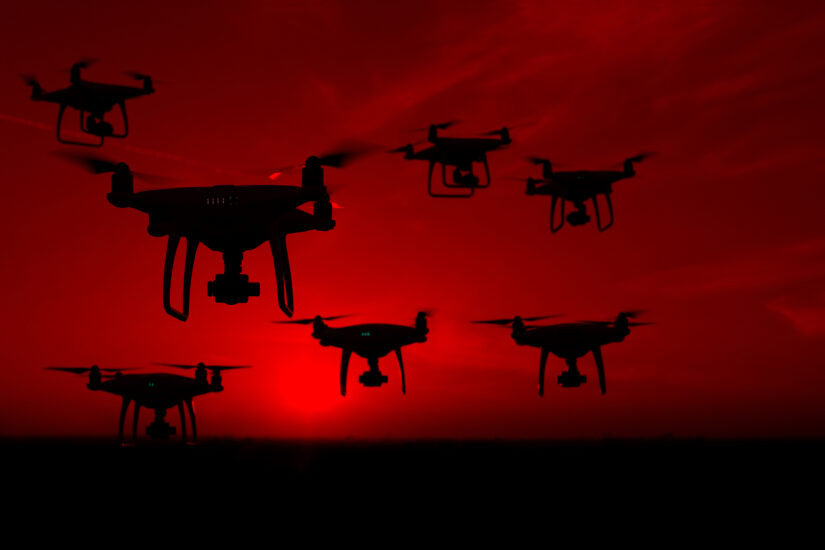Drones, Drones, and More Drones
5 Advanced Air Mobility Experts Enlighten Us on What Will Soon Be Ubiquitous in the Skies Overhead


Gabriel Casterline PM Coordinator/Drone Specialist at Amentum
Tell me about how you envision drones being used 5 years from now, 10 years from now?
5 years from now I envision that drone delivery become more prevalent and more widely accepted. The models will be smaller with better capabilities causing them to be faster, quieter, smaller, and most importantly safer.
10 years from now I am hoping to see testing on commercial and cargo transportation drones to be in full swing. I don’t expect them to be replacing 747s but I do see companies testing these capabilities.
What are the top three challenges drone manufacturers face today?
The major challenges for drone manufacturers that I have personally come across are varied across the companies that I have worked for. Material quality inconsistency is something that touched and challenged every company at one point or another, but it is still relevant today in the drone world. As everyone knows engineering is part of the manufacturing life cycle and I have seen engineering teams relying on the simulations over real world testing being a growing trend and causing many shocked faces when off nominal events occur because it wasn’t projected in any of their simulations. Lastly not fully developing servicing schedule is a common occurrence causing drones to hit the end of their life cycles sooner than intended or having preventable issues arise if only a bearing was greased.
What are the top three challenges drone operators face today?
As one would expect drone operators face very different challenges than the manufactures. Drone operators are the ones that have the most interaction with the public whether that’s positive or negative. Many drone operators are facing bottle necks in their careers due to many employers requiring pilot certificates thinking that makes for a better operator when many pilots don’t and won’t ever have the same expertise in the drone world. Many experienced drone operators are being pushed out of their jobs by their employers because they can hire less experienced people for less to do the role, without thinking about how the experience effects how the operators react to less than perfect situations.

Manoel Coelho CEO @ Speedbird Aero
Tell me about how you envision drones being used 5 years from now, 10 years from now?
Independently of the time frame, I believe we should always identify areas where drone technology can make a positive difference when compared to the current scenarios. In 5 year’s time, we will have a much more robust and established / proven drone technology where safety will no longer be a major differentiating factor but the right use cases and business models. In 10 year’s time, drones will operate in automated fleets, managed by AI systems (UTM & USpace completely integrated with manned aviation’s ATM). This will reduce the need for human pilots and allow for large-scale, simultaneous operations, but at the same time will create new jobs and opportunities.
What are the top three challenges drone manufacturers face today?
- Complex and Fragmented Regulations: Different countries have their own regulatory bodies with varying rules about standard and safety equipment drones can be operated. In many regions, laws are still evolving, making it difficult for manufacturers and operators to plan globally consistent operations. This is critical especially during this initial phase as there is no scale yet in any particular country or region, making it a necessity for drone manufacturers to expand internationally.
- Transition to Commercial and Aviation-Grade Standards: As drones move from being primarily used by hobbyists to becoming critical components of commercial and industrial operations, the industry is undergoing a gradual shift toward aviation-grade standards. The future of drones depends on both the industry’s shift toward more aviation-like professionalism and the regulators’ ability to adapt to new technologies. By embracing this dual approach, the regulatory framework can leverage the aviation safety culture while allowing drones to grow and thrive in ways that are suited to their unique characteristics and capabilities.
- Technological Development: As the demand for advanced drone capabilities grows, manufacturers must continually innovate to keep pace with technological advancements. This includes developing reliable systems for autonomous navigation, improved battery life, and enhanced payload capacity. Keeping up with rapidly changing technology requires significant investment in research and development, which can be a barrier for smaller companies.
What are the top three challenges regulators face now?
- Developing Comprehensive Regulatory Frameworks: One of the primary challenges regulators face is the need to create comprehensive and coherent regulatory frameworks that can effectively govern the diverse and rapidly evolving drone landscape. This includes establishing clear guidelines for safety standards, operational limits, and technological requirements like Remote ID, detect-and-avoid systems, and flight termination systems. The regulatory frameworks must also account for the unique characteristics of unmanned aerial systems (UAS) while ensuring that they do not stifle innovation or delay the deployment of beneficial applications such as drone delivery, agriculture, and infrastructure inspection.
- Integrating Drone Operations with Existing Air Traffic Management: As the number of drones in the airspace increases, regulators face the challenge of integrating these operations with existing Air Traffic Management (ATM) systems. This integration is crucial for ensuring the safe coexistence of manned and unmanned aircraft in shared airspace. Developing effective Unmanned Traffic Management (UTM) systems that can communicate and coordinate with traditional ATM frameworks is essential, but it requires significant investment in technology and collaboration among various stakeholders, including government agencies, industry players, and local authorities.
- Addressing Public Concerns and Building Trust: Gaining public acceptance of drones is a significant challenge for regulators. Concerns about safety, privacy, noise pollution, and the potential for misuse must be addressed to foster trust in drone operations. Regulators need to engage with communities, educate the public about the benefits of drone technology, and establish clear guidelines that protect citizens’ rights while enabling the safe and responsible use of drones. Building this trust is essential for the successful integration of drones into everyday life and for encouraging widespread adoption of innovative drone applications.
By addressing these challenges, regulators can create an environment that supports the safe growth of the drone industry while ensuring that public interests are prioritized.
Which category of special purpose drones have the greatest opportunities over the next 5 years?
Drone delivery and unmanned aerial logistics services present the most significant opportunities for scaling over the next five years. This category offers substantial benefits to society and the environment, as drones can revolutionize the way goods are transported by providing faster, more efficient, and safer delivery options. With the ability to bypass traditional traffic congestion and reduce delivery times, drones can help meet the growing demand for rapid logistics solutions. Additionally, their potential to minimize carbon footprints through reduced vehicle emissions makes them a more sustainable alternative to conventional delivery methods. As technology advances and regulatory frameworks evolve, we can expect drone delivery to become an integral part of modern logistics, transforming supply chains and enhancing customer experiences.
Is there anything drones are capable of that you think the public at large isn’t aware of but should be?
From Speedbird Aero’s perspective, we have pioneered with two other expert partners, the first real-time water analysis system using drones in the U.K. This innovative system eliminates the traditional need to collect water samples and transport them to a laboratory for testing. Instead, our drones provide immediate, actionable data, which is crucial for enhancing public safety and health assurance. By offering real-time insights, this technology enables quicker responses to potential contamination and helps authorities take proactive measures to safeguard water quality, ultimately benefiting communities and ecosystems alike.
In addition to Real-time Water Analysis, one of my favorites and recent operations is Ship-to-Shore. Delivering and picking up small and medium cargo to ships at anchor has a very positive impact to every stakeholder involved.

Angelo Collins Executive Director, Vertical Flight Society
V
Tell me about how you envision drones being used 5 years from now, 10 years from now?
General public perception of drones will be mixed since one way attack drones using first-person view (FPV) have become something out of a nightmare in Ukraine. Americans and most of the west will be somewhat shielded from the PTSD incurred from the sound of a small drone in close proximity, but anyone involved in the conflict will have mixed feelings. On one hand, they’ll understand the power and value of drones in both a cargo and military capacity, but also the nefarious potential.
What are the top three challenges drone manufacturers face today?
Drones may be regulated and treated as a possible weapon in the future, which will stifle their ability to Market and sell them. The entire market will likely be heavily regulated, even in the toy market.
2nd, the power required to provide on board computing for enhanced sense and avoid and AI needs to improve.
3rd, the ability to operate over populated areas is still in question, and it will be challenging for the FAA to ensure safety while also allowing for complex and dense Flight traffic at low altitudes.
What are the top three challenges drone operators face today?
The FAA and regulations as discussed. You can also select from above as these may be more applicable to operators.
What are the top three challenges regulators face now?
Ensuring safety is key. Being able to monitor numerous drones in a small area is a challenge. And as discussed above, ensuring drones are not used in nefarious ways, such as a weapon.
Is there anything drones are capable of that you think the public at large isn’t aware of but should be?
Drones can fly to a perch, similar to birds, and provide intelligence, surveillance, and reconnaissance (ISR) and eyes on an asset, without making sound or using much power. This would be useful to police, FBI, and border patrol.

Dennis Krause Co-founder & Chief Operating Officer @ Angel Aerial Systems
Tell me about how you envision drones being used 5 years from now, 10 years from now?
I see drones becoming indispensable in public safety, particularly through the expansion of Drones as First Responders (DFR). This concept involves drones being deployed remotely from docking stations on rooftops or strategic locations to respond to 911 calls or other emergencies. They serve as the first eyes on the scene, offering real-time situational awareness to incoming first responders.
As FAA regulations around Beyond Visual Line of Sight (BVLOS) evolve, we expect that police departments and emergency agencies will be able to deploy drones across cities more easily, without needing waivers or visual observers. While only a small number of police departments currently use DFR, the potential market is massive, with over 18,000 police departments in the U.S. alone.
Looking further ahead, drones could be near-fully autonomous first responders, not only providing real-time data but also delivering medical supplies, conducting search and rescue missions, and coordinating disaster relief efforts.
What are the top three challenges drone manufacturers face today?
Supply chain issues: There is a lack of a strong Western supply chain for critical drone components. Most cost-effective electronic components come from China, which creates compliance issues for manufacturers adhering to U.S. NDAA restrictions that prohibit the use of Chinese-made parts.
Lack of success stories (outside of DJI): DJI’s dominance in both the consumer and enterprise sectors has led to difficult exits from drone companies such as 3D Robotics, Intel and GoPro. This poor track record has hindered new entrants from attracting capital, talent and partnerships.
Data security: As drones collect vast amounts of sensitive data, ensuring cybersecurity and complying with regulations is increasingly complex and resource-intensive.
What are the top three challenges drone operators face today?
FAA regulations: BVLOS waivers have been a significant limitation on operational efficiency, but anticipated regulatory changes should ease these restrictions and reduce operational complexity.
Flight endurance: Limited battery life affects how long drones can remain on the scene, particularly for critical missions like DFR, where extended hover times could save lives.
Country of origin concerns: Many U.S. operators rely on Chinese drones, but looming legislation and tariffs targeting Chinese manufacturers like DJI have created uncertainty. Operators are hesitant to invest in a product that may face bans or to switch to alternatives that don’t yet match DJI’s performance and cost-effectiveness.
What are the top three challenges regulators face now?
Safety in urban airspace: As Beyond Visual Line of Sight (BVLOS) adoption grows, regulators must ensure safe drone operations in increasingly crowded and complex urban airspaces.
Balancing innovation with privacy and security: The growing use of drones in public safety and commercial sectors raises privacy and data security concerns that regulators must address without stifling innovation.
Keeping pace with technology: Rapid advances in drone technology, particularly in AI and autonomy, require regulators to constantly adapt, ensuring safety while enabling innovation in areas like autonomous DFR systems.
Which category of special purpose drones have the greatest opportunities over the next 5 years?
Public safety drones, especially for Drones as First Responders (DFR), present the greatest opportunity. Police, fire departments, and emergency responders will increasingly use drones to quickly respond to incidents. Regulatory changes around BVLOS will make it easier for drones to be deployed from strategic locations, providing instant situational awareness, reducing reliance on ground personnel, and improving emergency response times.
Is there anything drones are capable of that you think the public at large isn’t aware of but should be?
Yes, I believe the public isn’t fully aware of how widely drones are already being used in public safety. While delivery and urban air mobility applications are still in their early stages, drones are already providing critical real-time video and data to public safety officials, reducing risks and saving lives. Drones are making a significant impact today, helping overstretched agencies manage their resources more effectively.
Is there anything you would like me to know about drones that I haven’t asked you about?
The upcoming FAA regulations around BVLOS operations will revolutionize the drone industry, particularly for public safety applications. Once these rules are in place, Drone as First Responder (DFR) programs will expand rapidly, allowing fully autonomous, remotely operated drones to perform a wide range of critical missions. This will not only improve response times but also reduce risks for human personnel in high-stakes situations, creating a safer, more efficient emergency response ecosystem.

Bentzion Levinson
Founder & CEO Heven Drones
Tell me about how you envision drones being used 5 years from now, 10 years from now?
In 5 years from now drones will be used at scale in a variety of industries from Defense to Ag and construction. These drones will do high-value missions and will be automated with supervision from far.
In 10 years, we will see the price of drones go down dramatically, therefore they will be relevant for many more use-cases. We will also see full autonomous flight for many use-cases.
What are the top three challenges drone manufacturers face today?
- Regulations – there isn’t a clear path to scale drone operations autonomously just yet. This means you need to have more human operators which makes the operations much more expensive.
- Public Opinion – the public is still getting used to drones.
- Component availability – the ecosystem for building drones at scale is still being built.
What are the top three challenges drone operators face today?
Very similar to the MFG challenge as they bounce off each other.
What are the top three challenges regulators face now?
- They need to create a new framework for this new reality where millions of autonomous drones will fly above our heads.
- It’s not clear whose responsibility this falls on.
- Defense agencies still want to control a lot of the airspace, which makes it harder to create clear guidelines.
Which category of special purpose drones have the greatest opportunities over the next 5 years?
Drones that will replace complicated jobs that are high value. This is across many industries in both defense and commercial.
Is there anything drones are capable of that you think the public at large isn’t aware of but should be?
Drones have great safety and autonomous capabilities- today!



